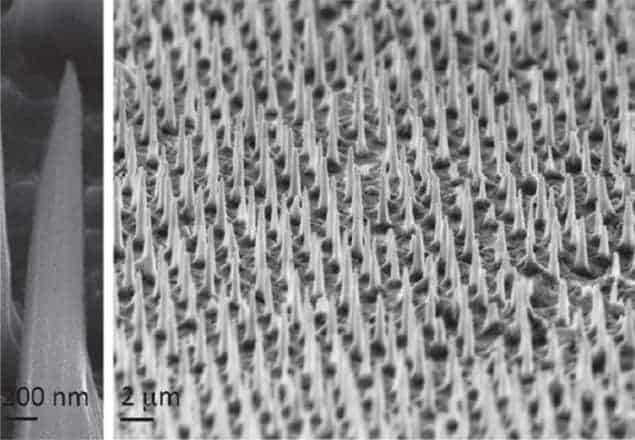
Biocompatible silicon nanoneedles, which can efficiently deliver nucleic acids and nanoparticles into biological cells without damaging them, have been developed by an international team of researchers. The porous needles are capable of delivering these drugs into live cells that are normally difficult to penetrate, and the technique could help damaged organs and nerves to repair themselves, and could also act as intracellular pH sensors.
The researchers, based at Imperial College London and the Houston Methodist Research Institute in Texas, made their nanoneedles using photolithography techniques. The structures can be patterned onto standard silicon chips in different ways, and the length and width of the needles can also be adjusted. Because they are porous, they can be made to take up a significantly greater amount of nucleic acid, nanoparticles and other therapeutics. Importantly, the porous silicon from which they are made is biocompatible – unlike ordinary silicon – and it clears the body in about two days, without leaving behind any toxic residue.
The plasma membrane and “endo-lysosomal compartment” of a cell are major biological barriers that limit the therapeutic efficiency of many drug-delivery vehicles by preventing nanostructures from entering the cells. According to team member Ennio Tasciotti from the Department of Nanomedicine at the Houston Methodist Research Institute, the new nanoeedles can “successfully deliver nucleic acids into cells, bypassing their plasma membrane and endo-lysosomal compartments without damaging the cell”.
New vessels
The researchers, co-led by Molly Stevens of Imperial College, found that their nanoneedles could be used to deliver nucleic-acid DNA and quantum dots into live human cells in the laboratory. They also found that they could deliver nucleic acid into the back muscles in mice. After just a week, they noticed that new blood vessels had grown in the animals’ muscles, and that these vessels continued to form over a further two weeks. The technique did not cause inflammation or any other harmful side effects.
Nucleic acids are the building blocks of all living organisms – they encode, transmit and express genetic information. If delivered into live cells, using the nanoneedles, for example, they could re-programme cells to make them carry out various functions. Such genetic programming could allow for personalized medical treatments for patients in the future.
Delivering quantum dots
The nanoneedles can release nucleic acids to cells – a process that is often difficult. At present, gene reprogramming and neuronal gene transfer is usually done with retroviral vectors, a technique that is complicated and expensive. Quantum dots – tiny specks of semiconductor material only a few molecules in size – can be used to monitor microscopic processes including those occurring inside biological cells. They are easy to track inside a cell because they brightly fluoresce, but getting them into a cell in the first place is not easy. The new nanoneedles could help to overcome this problem.
‘Flexible bandages’
In the future, the team hopes that its nanoneedles could be used to treat damaged nerves and promote nerve reconstruction. Stevens says that she and her colleagues are now hoping to combine their nanoneedles with various biomaterials to make “flexible bandages” that could be applied to different parts of the body, either internally to the tissue of interest or externally onto the skin. These bandages would deliver the nucleic acids needed to repair and reset cell programming. Although still a long way off, such bandages could ultimately help to repair damaged tissue. They might also be doped with metals to become conductive and make implantable restorable electronics.
The work is published in ACS Nano 10.1021/acsnano.5b01490.
- This article first appeared on nanotechweb.org



